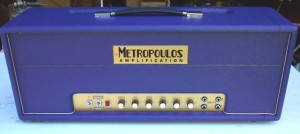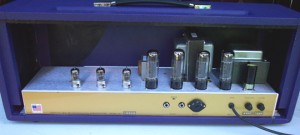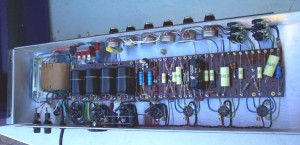Introduction
"I want an amp that can nail the early Van Halen tone 100% but I don’t have $5,000+ (at the time of this writing – 11/05) for an original Marshall ’67-’68 era plexi." This is what many of you have written to us and asked for in the past. "What should I use?"
Some of you have even had more demanding requirements for your amplifier citing that in addition to the Van Halen tone, you ALSO wanted the ability for the amp to respond and produce tones as diverse as Cream, Jimi Hendrix, Led Zeppelin, and AC/DC, among others.
Well, that’s a tall order, and besides finding the amplifier of choice, of course one must also factor in the speakers, guitars, pickups, and last – but certainly not least – one’s playing technique. So assuming you’ve got the other ingredients in order, let’s go ahead and focus on the amp.
 Metropoulos Amplification’s ’68 12000-Series Plexi 100 watt amplifier head is based on owner George Metropoulos’ own circa early ’68 100 watt Marshall, and his idea was initially to provide an amp that could nail the smooth gain and attack of the famous Marshall used by Van Halen. But, not satisfied with that alone, George also wanted to have the amp be able to respond and sound like the great classic Marshall rock tones like those you’d hear from live Led Zeppelin or Cream or Hendrix. So essentially, George’s amp could be considered a response to many of our own reader’s requests! Interestingly enough though, George and I have never had this discussion, but perhaps he has ESP because he delivered exactly what many of you had asked for.
Metropoulos Amplification’s ’68 12000-Series Plexi 100 watt amplifier head is based on owner George Metropoulos’ own circa early ’68 100 watt Marshall, and his idea was initially to provide an amp that could nail the smooth gain and attack of the famous Marshall used by Van Halen. But, not satisfied with that alone, George also wanted to have the amp be able to respond and sound like the great classic Marshall rock tones like those you’d hear from live Led Zeppelin or Cream or Hendrix. So essentially, George’s amp could be considered a response to many of our own reader’s requests! Interestingly enough though, George and I have never had this discussion, but perhaps he has ESP because he delivered exactly what many of you had asked for.
I’m going to cut to the chase. After the first experience plugging my Les Paul into Metropoulos Amplification’s ’68 12000 series Plexi attached to my early Marshall basketweave cabinet loaded with Celestion Pre-Rola Greenbacks, my heart started racing excitedly as I heard ALL those great tones again like I had only experienced with the very best of the original plexi-era Marshall amplifiers. Now, there are many amps being built today that can get you into the ballpark of the early plexi tones or will deliver most of the vibe, but I’ve never heard any other amp on the market capture this tone as authentically or with such detail as I did with Metropolous Amplification’s ’68 12000 Series Plexi. If you’ve been wanting these early Van Halen tones, but with the added flexibility to nail anything from AC/DC, to Cream, to Hendrix – all at the flick of a switch – then THIS is your amp – period.
How’s that for your review? That was an easy one for us! Oh, hmmm…now you need more information about the amp and want to know about what makes it unique? What’s all this about getting these other tones "at the flick of a switch" you ask?
Features
For those in the know, the original Marshall 12000-series amps (called that because they had serial numbers that were in the 12-thousands) made from late 1967 through 1968 have specific circuit and component configurations that are unique compared to those that came before or after them. (Note: There was also the 10,000-series amps from circa 1966 through 1967, but those varied from having the larger 2" core output transformers and larger power transformers, to later having variations in circuits that were identical to the 12,000 series – I own a ’67 Super Bass myself that fits this category). But as far as the 12,000-series configuration, this doesn’t mean that they are better or worse than what came earlier or after them, but what it does mean is that they were a unique series that captures a particular sound that could grind with gain (in the case of the Super Lead), but also do so without being sharp on the upper frequencies. Later plexi models were voiced more aggressively but with added treble to achieve the affect, in addition to other changes in filtering, affecting the feel.
Back to our amp here, on the outside, the Metropoulos Amplification 12000 Series Plexi has identical controls as a standard Marshall non-master volume amp. Controls for Presence, Bass, Mid, Treble, and Volume 1 and Volume 2 are on the front panel as well as four inputs for the respective two input channels. The channels can be "jumpered" just like on the original amps.
 The amp is fully hand-wired, point-to-point just like the original series Marshalls. Our test unit came equipped with the Mullardreissue EL34 output tubes as well as Groove Tubes 12AX7M "Mullard" preamp tubes. George will accommodate any requests for other tube types and is also currently evaluating various big bottle 6CA7/EL34 tubes as well.
The amp is fully hand-wired, point-to-point just like the original series Marshalls. Our test unit came equipped with the Mullardreissue EL34 output tubes as well as Groove Tubes 12AX7M "Mullard" preamp tubes. George will accommodate any requests for other tube types and is also currently evaluating various big bottle 6CA7/EL34 tubes as well.
Next to the power switch is the standby switch. This isn’t any ordinary standby switch, however. It’s the reason why this amp can deliver VH to Zep. The standby switch is actually a 3-way toggle dubbed the "Dual Voltage mod" and allows the switching between different plate voltages within the amp. In the lowered position, the B+ voltage at the plates is approximately 400 volts. This is the range that brings you into VH territory, just as if you had placed a Variac inside. The top end rolls off a bit, the feel becomes spongier, and the overall gain is smoother. And in fact, the reduced plate voltage equals a little bit more distortion as well. It’s the "Brown Sound" reincarnated.
Click the standby switch to the up position and you’re now at approximately 500 volts of B+ plate voltage. Proper biasing of the output tubes also appropriately scales with the mod. This setting provides the attack and dynamic range for the Zep and AC/DC tones. Plug in a Strat, and you’ve got a really warmed up circuit where Hendrix sounds can be revealed.
The Metropoulos Amplification 12000 Series Plexi cosmetically is housed in flat-lip style plexi head box (unavailable at the time of this review – our test unit came in a late ‘68/early ’69 style box), with a chassis that has the same circuit layout as the originals. That means that it’s got the filter capacitors underneath the chassis, and it has its output transformer placed in the same parallel field direction as the originals before they were rotated in late ’68. This might not mean much to the average player, but the placement of the transformers actually affects tone because they generate a magnetic field. And because of this, the environment they are within affects the other components within the "field". Interestingly enough, Marshall "corrected" the placement of the output transformer during the middle of 1968, while at about the same time, they placed the filter capacitors on top of the chassis. This configuration remains through to this day.
 George himself is also very familiar with the various Marshall eras and designs and resulting tones and so he was determined to capture what it was that made his own Marshall unique. The secret it turned out, wasn’t simply duplicating the circuit. In fact, the ’68 12000 series Plexi George sent us is bone-stock to spec. But, it’s got THE magic. How did George do this? And all with no brittle top end in the crunch attack of the amp?? Read on.
George himself is also very familiar with the various Marshall eras and designs and resulting tones and so he was determined to capture what it was that made his own Marshall unique. The secret it turned out, wasn’t simply duplicating the circuit. In fact, the ’68 12000 series Plexi George sent us is bone-stock to spec. But, it’s got THE magic. How did George do this? And all with no brittle top end in the crunch attack of the amp?? Read on.
Design and Construction
George explained it was all in the details. The output transformer was perhaps among the most critical piece. The output transformer plays a huge role in these amps as the amps are cranked up and the power tubes saturate. The tone (good or bad) that results can largely be attributed to that output transformer. Basically, the quality of the iron and materials and the specific grade of materials used today are much different from what was used in the past. So what that meant was that not only the exact winds had to be duplicated, but that the grade of steel was looked at and matched to what was used in the past.
The second key area of detail is within the circuit itself. Though the components are going to be rated the same between the original and George’s ‘68 – a 10K resistor is a 10K resistor for example -, certain components tolerances were prone to being a little off spec. A 10K may read a bit lower or a bit higher (e.g., 8K or 11K). All of these elements make a difference. The amp was built accordingly within the tolerances that George required.
In the Listening Room
You’ve already read enough about us gloating over the amazing tones of this amplifier. So rather than continue with more of this, let us explain why this amp has us especially excited.
Marshall players know that you’ve got to crank them up to get the power tube saturation going. However, we also know that getting all the right frequencies to come through as we like can be difficult when playing at those louder volumes. Simply put, getting the "magic" tone at volume can sometimes be a headache and a challenge – this one does it – you get the VH tone in spades that is really smooth, and bold AT volume as well as the best Marshall plexi tones of this series at playable volumes. To me, this was a big deal and a big reason why this amp is magic to my ears.
Out of the many, many Marshalls I’ve owned, I can probably only designate two or three of them that had "the magic" with regards to the Van Halen type tone. And unfortunately because of the values and my financial conditions at various times, I was forced to sell them. Sure, a metal panel Marshall from the early ‘70s will get you in the realm of that tone with the right speaker cab and guitar/pickup combination, but there’s always something missing – usually there’s too much top end bite to the mix, not enough mid/growl to the signal, and the feel is a bit less relaxed like the original.
What the BEST Marshall plexis of this era will do is have a gain structure that is smooth and with a top end that is present but doesn’t "bite off the ears" like later Marshalls can and will do. In fact, it’s for this reason that basketweave-era cabinets I believe are SO popular – they make the average, brighter Marshall amp sound fantastic because the high-end peaks are rolled off within the speakers (if talking G12M 25 watt greenbacks) and because the weave material serves as a bit of a blanket or dampening material.
The Metropolous 12000-Series Plexi amp does exactly what the best Marshalls will do – it is voiced and feels perfect. And you don’t have to try and hunt down an old one to try and gamble to find one that has the magic tone. It’s all been done for you here.
Final Thoughts
When Metropoulos Amplification first came on the scene a few years back, we were immediately impressed with owner George Metropoulos’ attention to detail with his point-to-point board kits as well as the quality of both his component selection and the included instructions. Resident contributing writer Mike Mullen took on the task of transforming his JTM-45 reissue with a Metro board and vintage filtering and the results were stunning. To this day, we still discuss how his modded JTM-45 reissue has all the magic and tone of the very early aluminum chassis JTM-45 we were fortunate enough to experience.
Now moving away from simply providing kits, the ’68 12000 Series Plexi is just one of several amps that Metropoulos Amplification makes. They’ve got a JTM-45/100 clone ($2450) – an amp considered the "Holy Grail" by many, as well as a circuit based on ’67 Plexi ($2300) specs. If these amps are anything like what we’ve experienced with the ’68 12000 Series, George will no doubt be keeping himself very busy in the years ahead.
Now, what we have here with Metropoulos Amplification’s ’68 12000 Series Plexi is the very first amp that we’ve played that absolutely nails the tone of the same original series of Marshall 100 watters. With top notch construction and attention to all the most important details, the ’68 12000 Series Plexi plain and simply delivers the early Marshall 100 watt plexi tones like no other amplifier we’ve heard.